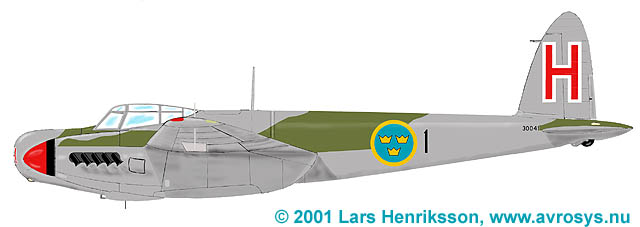|
|
||
|
J
30 - De Havilland Mosquito N.F. Mark XIX (1948-1954) |
||
|
|
Page 1 (2) |
|
|
|
||
 |
||
|
The
Swedish Air Force had no night fighter capacity before this purchase. All
Mosquitoes were to be based at Wing F 1 in Västerås, a former bomber
wing.
The
story behind the Mosquito is well-known. Due to the shortage of strategic
metals during WWII, de Havilland designed a twin-engine bomber
constructed of plywood and balsa wood. The choice of material gave a light
aircraft. It was engined by the now available powerful Rolls Royce Merlin
engines, which made the aircraft very fast.
Designed
originally as a bomber, this capable aircraft was used for many different
duties. It was also built in versions as fighter, reconnaissance aircraft,
night fighters (with radar), carrier-borne aircraft, torpedo aircraft,
transports, ground attack and much more. The ”pathfinders” got a
special reputation during WWII. They were Mosquito crews which led the
bomber armadas to their targets. They were specialist in precision
navigation and dropped flares from low altitude over the targets in
Germany, thus giving the four-four-engine strategic bombers the
possibility of precision bombing from a higher altitude. The night fighter version Mk XIX was fitted with Rolls-Royce Merlin 25 engines, each of 1633 hp. It had a maximum speed of 600 km/h. The radar was of American origin; type Signal Radio Corps 720 manufactured by Western Electric. It worked at the 3 GHz-band. In Sweden, it was designated PS20/A. A moving parabola antenna was installed in the nose of the aircraft, protected by a plexi-glass radome. The armaments consisted of four 20 mm automatic guns m/46A (Hispano). For training purposes, this installation could be replaced by four 12,7 mm guns.
Not
a single Swedish Mosquito was spared for the future. I quote the aviation historian
Mikael Forslund, who writes in his book J
30 Mosquito: ”Three
aircraft should have been spared. One could have been flown, another could
have been kept in a museum and the third sold to provide yet another
museum. So valuable the Mosquitoes have become today”. See the
bibliography
for more information about the book (which is provided with picture texts
in English).
Photo at top: J 30, marked Red D (David) at Wing F 6 at Karlsborg.
Length: 12,68 m. Span:
16,52, m. Maximum take-off weight: , 9
550 kg. Max. speed:600 km/h. |
|
|
|
Airfix has produced a plastic model kit of J 30 Mosquito with Swedish decals in scale 1/72. The model builder can choose between code Blue B and Yellow H. Catalouge number 03062.
|
|
|
 |
||
|
|
||
|
|
||
|
|
||
|
|
||
|
© Lars Henriksson |
Updated 2010-02-27 | |
|
Custom Search
|
||
